Bitter gourds are important vegetable crops grown for their immature tuberculate fruits. Fruits are rich in vitamins and minerals, including 88 mg of vitamin C per 100 grams. Fruits can be used after they have been cooked, and delicious preparations can be made after they have been stuffed and fried. When there is a shortage of fruits on the market, they are sliced, partially boiled with salt, dried under direct sunlight, and then stored for months.
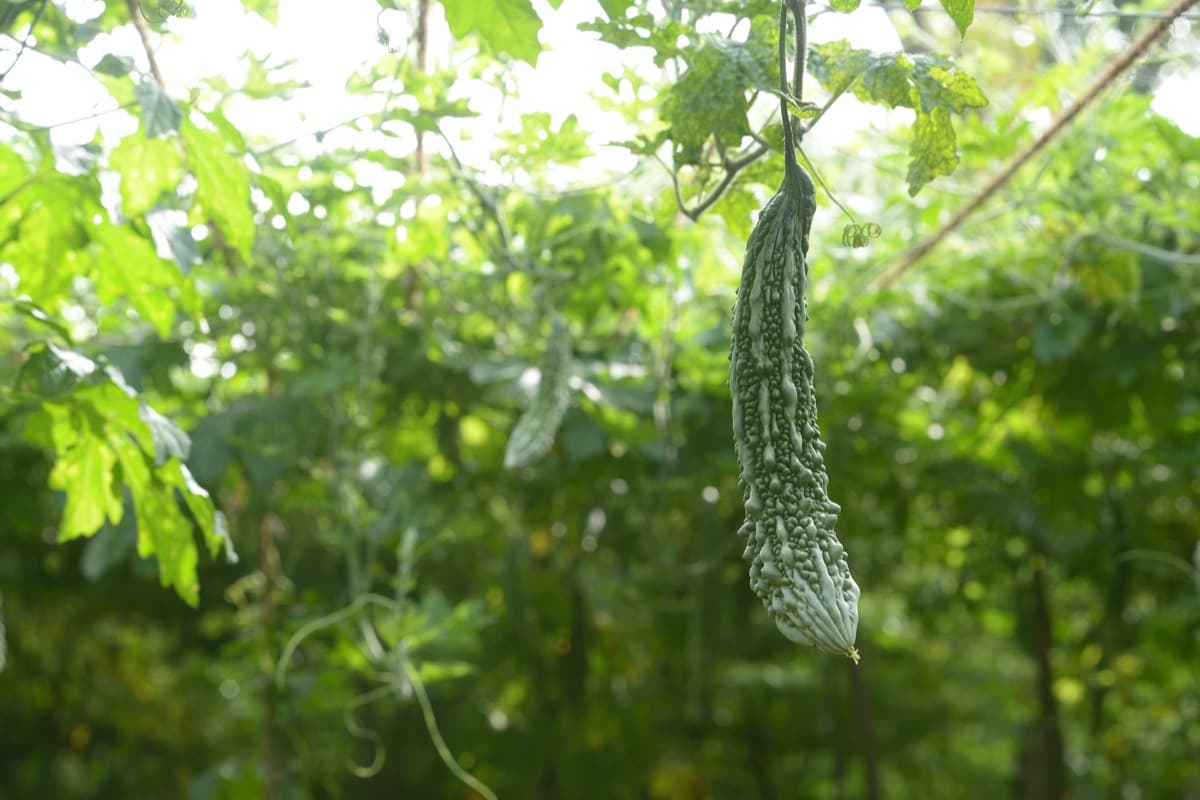
With deep green, deeply lobed leaves, and yellow, dioecious flowers, it is a luscious, climbing vine with slightly fuzzy stems. Among the states that grow bitter gourds are Maharashtra, Gujarat, Rajasthan, Punjab, Tamil Nadu, Kerala, Karnataka, Andhra Pradesh, West Bengal, Odisha, Assam, Uttar Pradesh, and Bihar.
Growing Bitter Gourd organically in Karnataka
How the Karnataka government encourages organic farming
Since 2015-16, Karnataka has facilitated the setting up of organic farmers’ associations throughout the state. Each farmer association has 70-150 farmers. These associations are federated into 15 regional cooperative organic farmers’ federations covering all 30 districts. They engage in procurement, processing, and market-related activities with some financial assistance from the state. In 2017, Karnataka brought a new organic farming policy.
The new policy focuses on providing value-chain linkages between producers and consumers and promoting sustainable organic production systems. The policy aims to convert 10 percent of the cultivable area into organic by 2022. However, as of November 2019, the state organic area was 111,000 ha, 1.1 percent of its net sown area. Since 2017-18, the state has promoted a market-based crop-specific organic cluster development to develop linkages between farmers and consumers by strengthening supply chain mechanisms.
Climate requirement for growing Bitter Gourd organically
The crop is mainly grown in subtropical and hot, arid regions during the warm season. The plants are susceptible to light frost and may provide some protection if planted during the winter months. Vine growth is optimum at temperatures between 24°C and 27°C. The seed should germinate when the temperature is higher than 18°C.
In case you missed it: How this Farmer Earning 25 Lakh Rupees from his Bitter Gourd Farm: A Success Story to Inspire
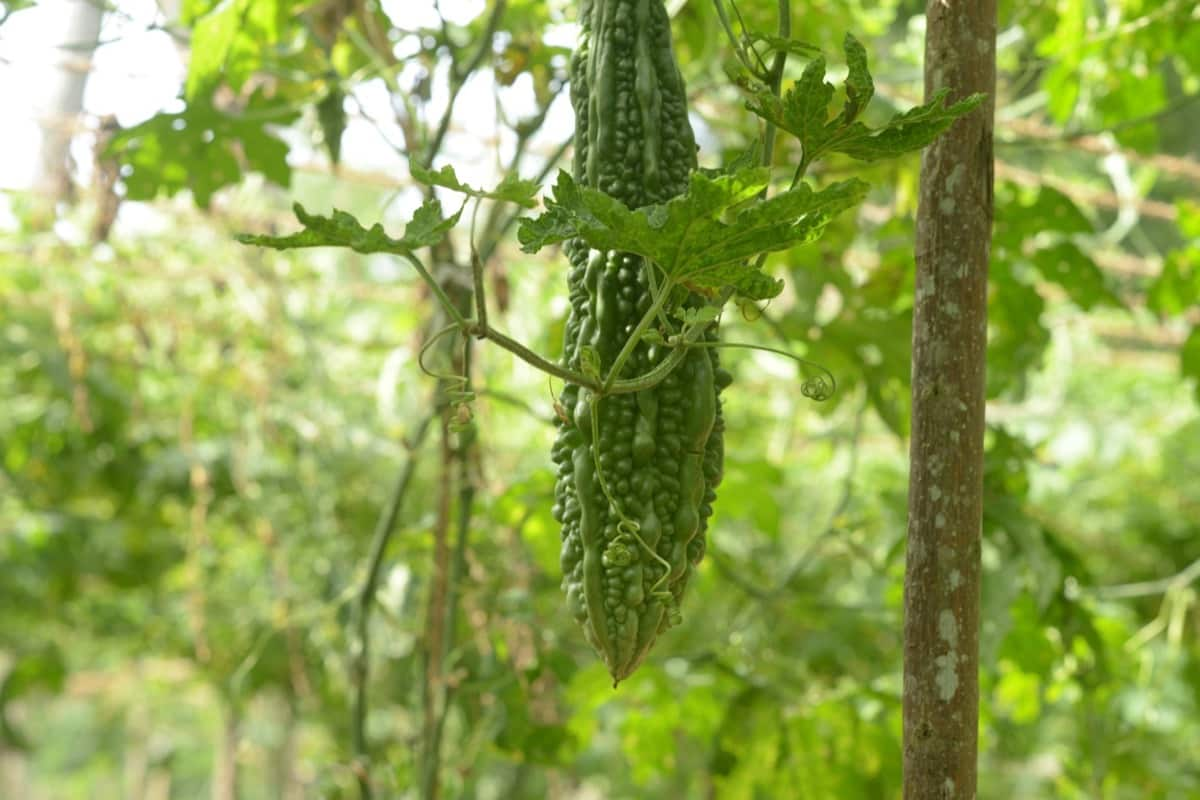
High humidity makes the crop vulnerable to various fungal diseases during vegetative growth. Bitter gourd seeds should be planted in a location that receives 6 to 8 hours of sunlight daily. Temperatures between 15 and 20°C are ideal for seed germination, but it can take as long as ten days.
Soil requirement for growing Bitter Gourd organically
Growing bitter gourd is possible in various soils, such as sandy soils, sandy loam, and medium black soils rich in organic matter. Many alluvial soils along riverbeds are good places to grow bitter gourds. The pH range of 6.0-7.0 is optimal for plants’ growth. Make sure the soil is well-draining and light enough for planting. Growing bitter gourd vines on the ground is ideal for mulching the soil to prevent the fruits from getting dirty or rotting in moist soil.
Seasons for Bitter Gourd Cultivation
June- July and January- February are the best times to start sowing seeds. Too much rain is not good for the plant and could cause diseases. The plant does great between the temperature of 14 and 35 degrees. The colder climate will cause flower drop and diseases, reducing yield. Maintenance of the plant is higher with lower temperatures, incurring costs for the farmer. Always ensure the right weather before planting bitter gourd.
Bitter Gourd varieties
In different regions, bitter gourd preferences vary depending on the size, color, presence or absence of tubercles/ridges, and bitterness of fruits. As a result, several varieties are developed in India, and the details are provided below:
Punjab Karela-15: It has smooth, serrated green leaves. Green and pubescent stem. Its long vines with smooth, serrated, dark green leaves. Fruits have a matt look and a dark green color. It has a mediocre level of resistance to bitter gourd yellow mosaic disease. The yield is 51q/acre on average.
In case you missed it: Organic Bitter Gourd Farming, Cultivation In India
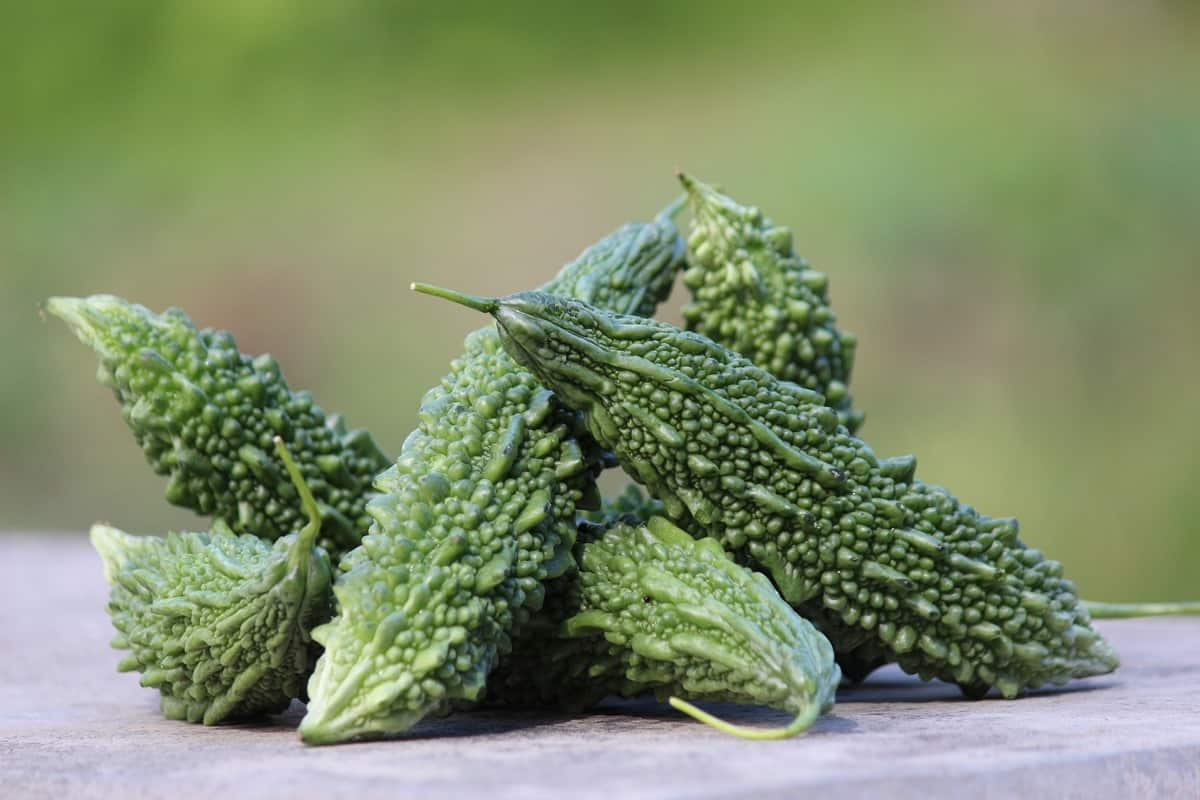
Punjab Kareli-1 (2009): Vines are long, green, smooth, and serrated leaves present. Its fruits are ridged, long, and green. The first fruit harvest occurs 66 days after planting. The average production is 70 q/acre, and one fruit weighs roughly 50 g.
Punjab Jhaar Karela-1 (2017): Its medium-length vines have green leaves with serrations. Fruits are aesthetically pleasing green, soft, spindle-shaped, and ideal for slicing during cooking. It is immune to viruses and root-knot nematode infections. It yields 35 q/acre on average.
Punjab-14: It has little vines. The fruit is pale green and weighs approximately 35g. It is ideal for planting in the spring and during periods of heavy rain. 50 q/acre on average is the yield.
Arka Harit: Fruits have smooth, regular ribs, a short, spindle-shaped shape, a green color, and a mild bitterness with 48 quintals per acre of yield. IIHR Banglore has released this variety.
Pusa Vishesh: By the IARI, New Delhi, this variety has been released and recommended for cultivation during summer. The vine is bushy and dwarf, making it easy to manage. They are green and fusiform with irregular breaks and smooth and glossy ridges on the surface. Their length is medium, and they are thick. The crop is early in maturity and takes about 55 days to harvest after sowing.
CO 1: The variety has medium-sized fruit, which is long and dark green. The fruits have an average weight of 100-120 gm. It gives an average yield of 5.8 t/acre, and the variety matures in 115 days.
COBgoH 1: The variety matures in 115-120 days and gives an average yield of 20-21 t/acre.
MDU 1: The fruit is 30-40 cm long and matures in 120-130 days. It gives an average yield of 13-14 t/acre.
In case you missed it: Bitter Gourd Project Report, Cultivation Cost, Profit (Karela)
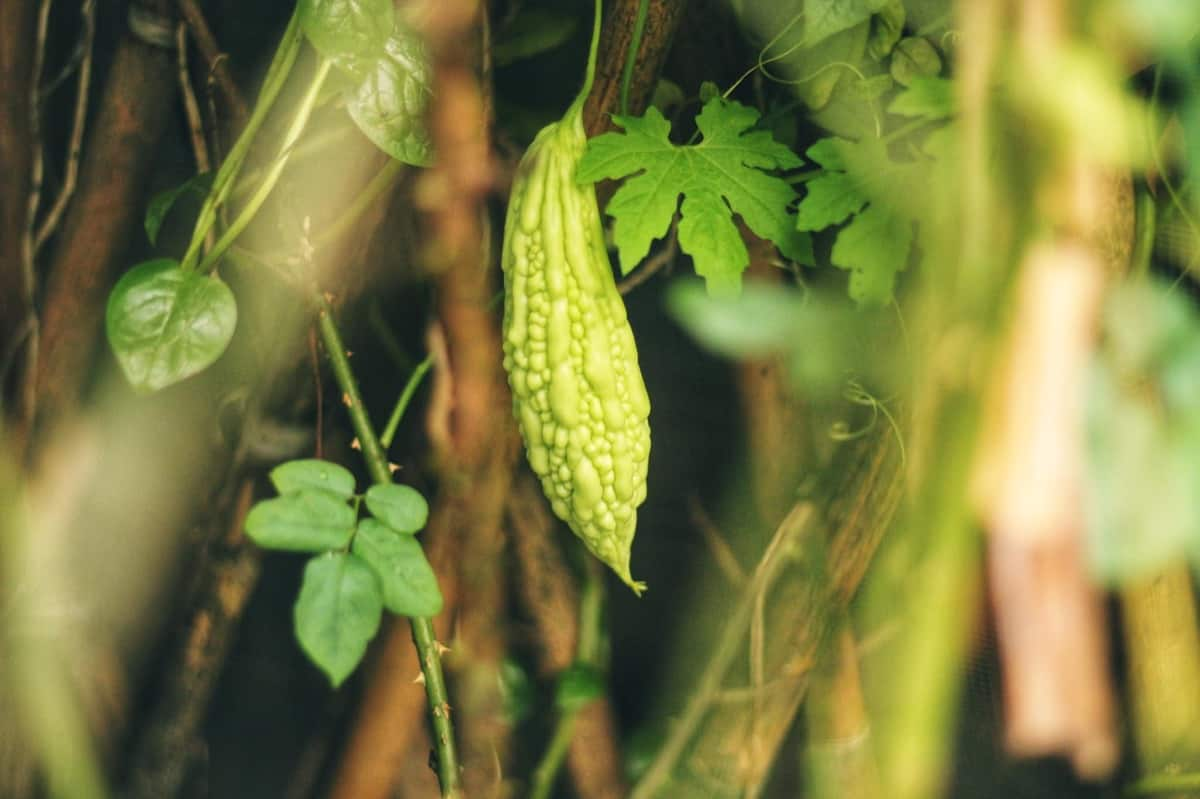
Land preparation for Bitter Gourd cultivation
The preparation of land, sowing, and other cultural practices for bitter gourd are similar to those for cucumber, except that bitter gourd is trained to bower or cut branches of trees. Karnataka cultivates the crop intensively. By plowing crosswise and leveling the land, the land is brought to a fine tilth. An average of 2 x 2 m spacing is used to make pits of 60 cm diameter and 30 – 45 cm depth. Pits filled with topsoil up to 3/4th height are filled with 8-10 tons of well-rotten farmyard manure per acre.
Sowing Bitter Gourd
In most cases, bitter gourds are planted by seed directly on the farm. There is also the option of using saplings, but the cost of saplings is much higher. Therefore, most farmers (95%) prefer to propagate bitter gourds from seeds. In addition to being easier and faster, this is also more economical. Bitter Gourd cultivation requires 1.5 to 2 kg of seeds per acre. After soaking for an hour, the seeds are dried in the shade for 24 hours. They are then treated to prevent diseases and pest attacks and planted directly in the field.
It is recommended to sow each seed at a distance of two feet apart. Between rows, the distance may range from 3-4 feet up to 7.5 feet. It depends on your personal preferences and needs. The right amount of space is crucial to fertilize the plants with a small tractor or move a large trolley for harvesting. Make sure the rows are spaced appropriately so that the plants can move between each other. As soon as the seeds are sown, the field should be irrigated.
Bitter Gourd Plant Support
As a weak climber, bitter gourd requires support to grow. As opposed to trailing on the ground without support, plants trailed on the support (bower) continue to yield for 6-7 months. Furthermore, these vines are less susceptible to pests and diseases because they don’t come in direct contact with the soil. Plants are planted at a spacing of 2.5 x 1m in the bower system. Irrigation channels are positioned at a distance of 5-6 m between furrows, which are opened at 2.5 m.
On both ends of the alternate furrows, wooden poles (3 m high) are pitched and wired together at a distance of 5 m. A network of wires is formed by connecting the wires along the furrows with cross wires at a 45 cm distance. The seeds are dipped along the furrow at a distance of 1 m and lightly covered with soil. It takes the vines 1.5-2 months to reach the bower height. In the initial stages of growth, the vines are trailed on ropes until they reach the pavilion. The new tendrils trailed on the pavilion once the vines reached the bower height.
In case you missed it: District Wise Crop Production in Karnataka: List of Crops Grown in Karnataka
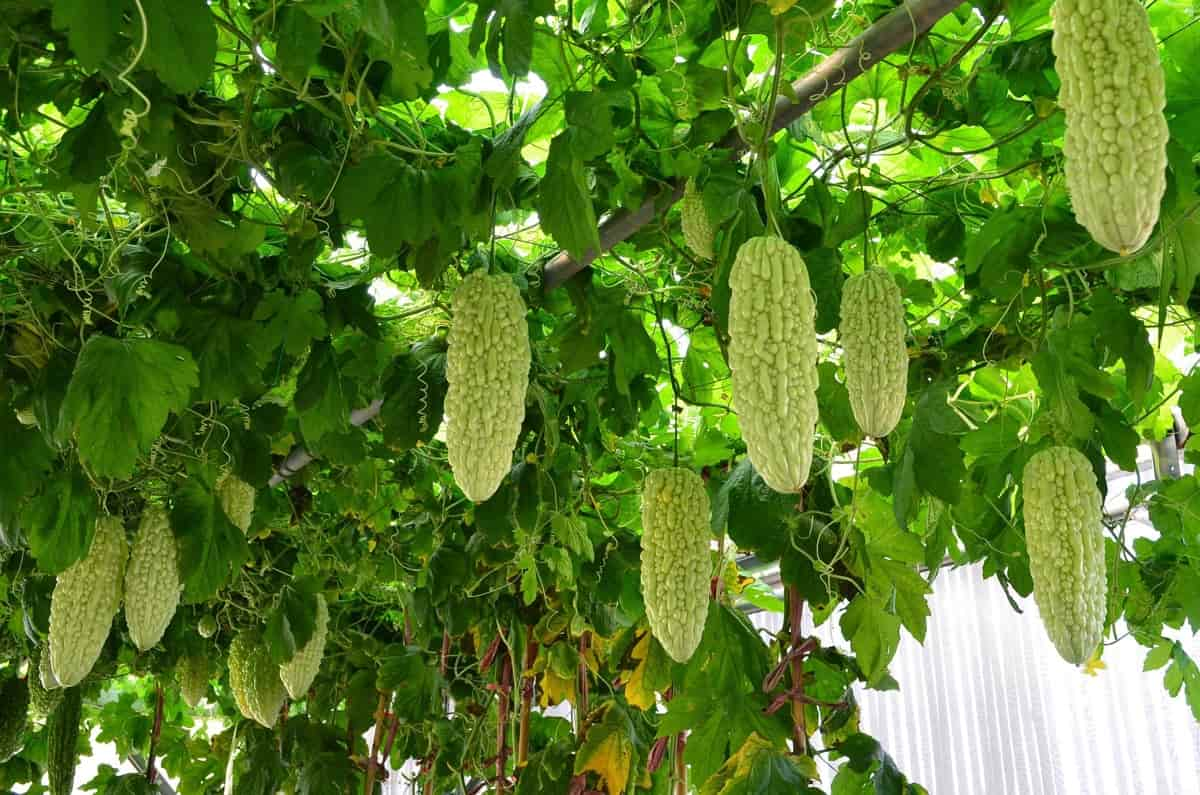
Bitter Gourd Manuring and Fertilization
Fertilizer doses will be applied based on the variety, soil fertility, climate, and planting season. The FYM is usually mixed with the soil during plowing when it has decomposed. A basal dose of 6-8 tons of FYM and poultry manure applied at 28 kg N/acre (on an N equivalent basis) and Azospirillum at 400 g/acre was the most economical organic nutrient schedule for bitter gourd. At flowering, the balance will be given. A ring of fertilizer is applied 6-7 cm from the base of the stem.
Bitter Gourd Irrigation
In the rainy season, irrigation is unnecessary if rains fall evenly between July and September. Ridges are usually irrigated a day or two before seeds are planted. The next irrigation should be given 4 or 5 days after planting seeds, preferably light. In the following weeks, irrigation is given at intervals of one week. For taproots to develop rapidly, moisture must be maintained at the root zone.
Pests in Bitter Gourd
Cucurbit fruit fly
Damage symptoms
- Larvae bore into the fruit and feed on pulp-forming lesions.
- Fruits decay due to secondary bacterial infection.
- Damage is more serious in melons. Fruits at an early stage also are attacked. However, such fruits do not develop—infestation results in a premature drop of fruits.
- Decay of fruits due to secondary bacterial infection
Control
- Collect infested and fallen fruits and bum in deep pits.
- Expose the pupae by plowing and turning over the soil after harvest
- Use attractants like citronella oil, eucalyptus oil, vinegar (acetic acid), and lactic acid to trap flies.
- Use poison baiting in severe infestation
- Keep 5 g of wet fishmeal in polythene bags (20 x 15cm) with six holes (3 mm dia)
Aphids
Damage symptoms
- Aphids can damage plants by sucking the leaf sap. In the early stage, leaves crinkle, and in severe cases, the plants wither.
- The leaves of fully grown vines turn yellow, and the plant loses vigor.
Control
- Aphids can be controlled with neem oil, insecticidal soaps, and horticultural oils, but they must come into contact with the insects. Follow the package instructions for application.
- The leaves of plants can be wiped or sprayed with a mild solution of water and dish soap to control aphids. For two weeks, soapy water should be applied every 2-3 days.
Leaf miners
Damage symptoms
- Initial symptoms of leaf miner’s infestations look like twisted marks in white color on leaves.
- The mines can be noticed 3 to 4 days after oviposition by the adults, and the size of the mine increases with the larvae’s maturity.
- Severe damage makes leaves appear like stipples; leaf mining by the larvae and stippling of leaves reduces the photosynthetic ability of the leaves.
- Extensive mining causes premature leaf drop where yield attributes of the crop are seriously reduced.
Control
- Lacewings, a range of parasitoid wasps, and beneficial nematodes provide some control of these insects.
- Some organic pesticides can provide control, although thorough coverage is required. For example, neem oil and Spinosad can be useful. Once ingested, Spinosad immediately halts feeding and kills the larvae after a few days.
In case you missed it: Bitter Gourd Farming; Karela Cultivation – A Full Guide
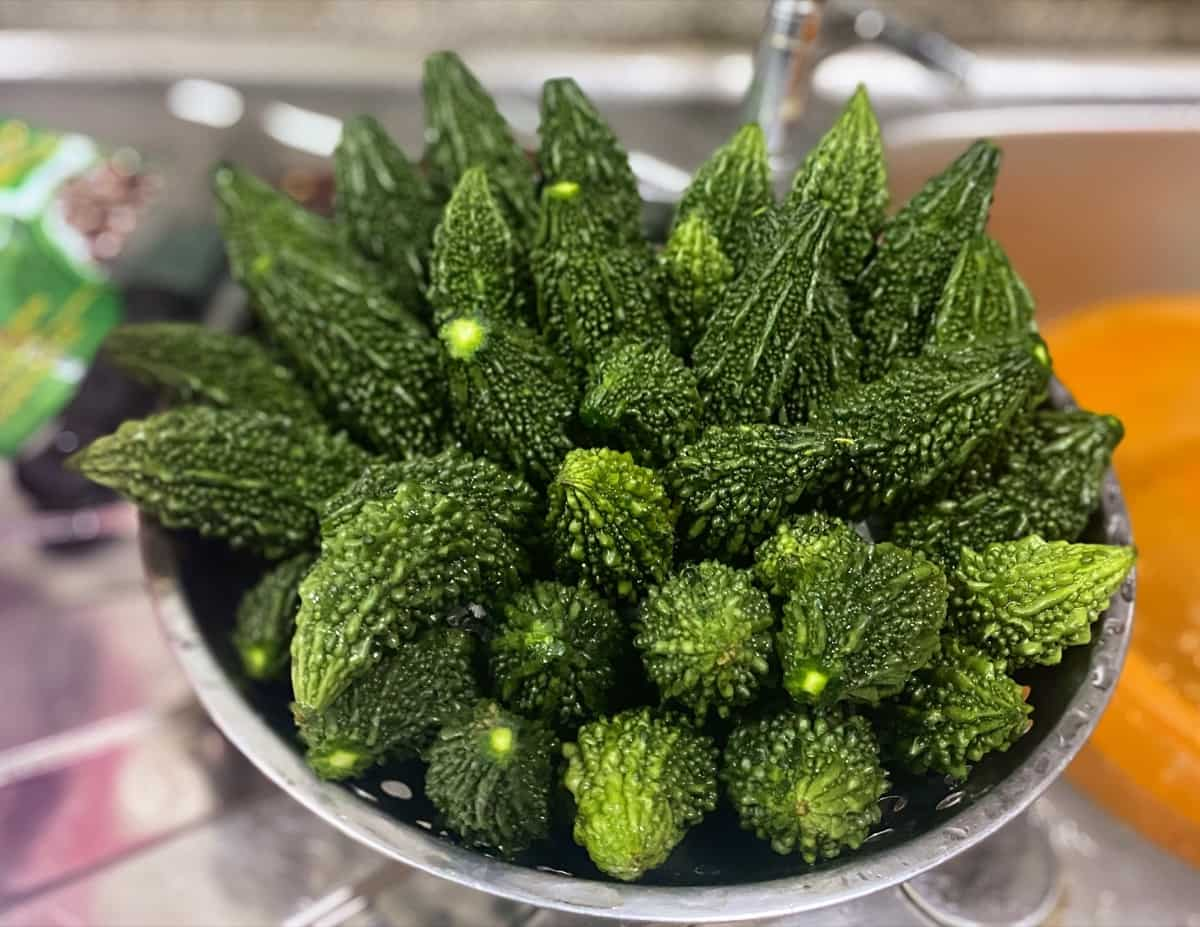
Diseases in Bitter Gourd
| Disease | Symptoms | Control |
Powdery mildew | 1. A white powdery residue is observed on the upper leaf surface. 2. circular patches or spots appear on the leaf’s lower surface. 3. Severely attacked leaves become brown and shriveled, and defoliation may occur. | 1. Baking Soda is the best known of the home-made, organic solutions for powdery mildew. 2. Potassium bicarbonate is a contact fungicide that quickly kills powdery mildew spores. |
| Fusarium Wilt | 1. Affected plants show yellowing, loose turgidity, and show drooping. 2. In older plants, the leaves wilt suddenly, and vascular bundles in the collar region. | 1. Remove and dispose of affected plants immediately. 2. Hand-pull or spot-treat weeds using a weed flamer or natural herbicide. |
Bitter gourd Witches’ Broom | 1. Diseased plants show many abnormally little leaves 2. The diseased plants bear many flowers and blossom earlier than healthy plants. 3. Plants showing severe witches’ broom do not bear any fruit. | 1. Diseased plants should be destroyed 2. Use of disease-free planting material 3. Pruning diseased parts along the basal 15-20 cm healthy portions. |
Bitter Gourd Harvesting and yield per acre
The bitter gourd crop takes about 55-60 days from the seed sowing until the first harvest. The bitter gourd fruit matures quickly and turns red in 2-3 days, so it should be picked then. The right time to pick fruit depends on the kind and variety of fruit. Fruits are usually picked when tender and green to prevent them from turning yellow or yellowish-orange during transportation.
The fruits should be harvested in the morning and stored in the shade after harvesting. Several factors affect bitter gourd yield, including the cultivation system, variety, and season. Organic fruit production is estimated to range from three to four tons per acre when grown organically.
Conclusion
Bitter gourd is sometimes referred to as bitter melon or karela in Hindi. Its botanical name is Memordica charantia, a member of the Cucurbitaceae family. Aside from its medicinal and nutritional benefits, it has many other excellent health benefits. The high demand for bitter gourds in the market makes bitter gourd farming successful.
- Types of Pesticides Used in Agriculture: A Beginner’s Guide
- Economical Aquaculture: A Guide to Low-Budget Fish Farming
- 15 Common Planting Errors That Can Doom Your Fruit Trees
- How to Make Houseplants Bushy: Effective Tips and Ideas
- Innovative Strategies for Boosting Coconut Pollination and Yield
- Pollination Strategies for Maximum Pumpkin Yield
- The Complete Guide to Chicken Fattening: Strategies for Maximum Growth
- Natural Solutions for Tulip Problems: 100% Effective Remedies for Leaf and Bulb-Related Issues
- Revolutionizing Citrus Preservation: Towards a Healthier, Greener Future
- Natural Solutions for Peony Leaf and Flower Problems: 100% Effective Remedies
- Maximizing Profits with Avocado Contract Farming in India: A Comprehensive Guide
- Natural Solutions for Hydrangea Problems: 100% Effective Remedies for Leaf and Flowers
- The Ultimate Guide to Choosing the Perfect Foliage Friend: Bringing Life Indoors
- From Sunlight to Sustainability: 15 Ways to Use Solar Technology in Agriculture
- The Ultimate Guide to Dong Tao Chicken: Exploring from History to Raising
- The Eco-Friendly Makeover: How to Convert Your Unused Swimming Pool into a Fish Pond
- Mastering the Art of Delaware Chicken Farming: Essentials for Healthy Backyard Flocks
- 20 Best Homemade Fertilizers for Money Plant: DIY Recipes and Application Methods
- How to Craft a Comprehensive Free-Range Chicken Farming Business Plan
- Brighten Your Flock: Raising Easter Egger Chickens for Beauty and Bounty
- How to Optimize Your Poultry Egg Farm Business Plan with These Strategies
- Subsidy for Spirulina Cultivation: How Indian Government Schemes Encouraging Spirulina Farmers
- Ultimate Guide to Raising Dominique Chickens: Breeding, Feeding, Egg-Production, and Care
- Mastering the Art of Raising Jersey Giant Chickens: Care, Feeding, and More
- Ultimate Guide to Raising Legbar Chickens: Breeding, Farming Practices, Diet, Egg-Production
- How to Raise Welsummer Chickens: A Comprehensive Guide for Beginners
- How to Protect Indoor Plants in Winter: A Comprehensive Guide
- Ultimate Guide to Grow Bag Gardening: Tips, Tricks, and Planting Ideas for Urban Gardeners
- Guide to Lotus Cultivation: How to Propagate, Plant, Grow, Care, Cost, and Profit
- Agriculture Drone Subsidy Scheme: Government Kisan Subsidy, License, and How to Apply Online
- Ultimate Guide to Raising Araucana Chickens: Breed Profile, Farming Economics, Diet, and Care
- Bringing Hydroponics to Classroom: Importance, Benefits of Learning for School Students
- Ultimate Guide to Raising Polish Chickens: Breed Profile, Farming Economics, Diet, and Care
- Ultimate Guide to Raising Australorp Chickens: Profile, Farming Economics, Egg Production, Diet, and Care
- Silkie Chicken Farming: Raising Practices, Varieties, Egg Production, Diet, and Care
- Sussex Chicken Farming: Raising Practices, Varieties, Egg Production, Diet and Care